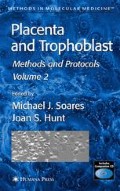Abstract
A wide variety of techniques has been developed for qualitative and quantitative analysis of gene expression in human cells and tissues. Two commonly used methods are reverse-transcription (RT)-polymerase chain reaction (PCR) to analyze the transcribed messenger RNAs (mRNA) and immunohistochemistry to detect the translated proteins. These techniques can be modified and adapted for use in analyzing gene expression in animal models. In particular, as a result of the close phylogenetic relationship between humans and nonhuman primates, human reagents, especially antibodies, cross-react with nonhuman primate tissues. However, the results are not always satisfactory as some antibodies may cross-react with irrelevant antigens in these tissues. In this chapter, we describe the use of RT-PCR and immunohistochemical techniques to analyze expression of Paan-AG, a novel class Ib major histocompatibility complex antigen in the olive baboon (Papio anubis) placenta. We used Paan-AG-specific primers to amplify Paan-AG transcripts from baboon placenta, and generated Paan-AG isoform-specific polyclonal antibodies for use in immunohistochemistry.
Access this chapter
Tax calculation will be finalised at checkout
Purchases are for personal use only
References
Bontrop, R. E. (2001) Non-human primates: essential partners in biomedical research. Immunol. Rev. 183, 5–9.
Adams, E. J. and Parham, P. (2001) Species-specific evolution of MHC class I genes in the higher primates. Immunol. Rev. 183, 41–64.
Arnaiz-Villena, A., Martinez-Laso, J., Castro, M. J., et al. (2001) The evolution of the MHC-G gene does not support a functional role for the complete protein. Immunol. Rev. 183, 65–75.
Doxiadis, G. G., Otting, N., de Groot, N. G., and Bontrop, R. E. (2001) Differential evolutionary MHC class II strategies in humans and rhesus macaques: relevance for biomedical studies. Immunol. Rev. 183, 76–85.
Langat, D. K. and Hunt, J. S. (2002) Do nonhuman primates comprise appropriate experimental models for studying the function of human leukocyte antigen-G? Biol. Reprod. 67, 1367–1374.
Geluk, A., Elferink, D. G., Slierendregt, B. L., et al. (1993) Evolutionary conservation of major histocompatibility complex-DR/peptide/T cell interactions in primates. J. Exp. Med. 177, 979–987.
McKinney, D. M., Erickson, A. L., Walker, C. M., et al. (2000) Identification of five different Patr class I molecules that bind HLA supertype peptides and definition of their peptide binding motifs. J. Immunol. 165, 4414–4422.
Boyson, J. E., Iwanaga, K. K., Urvater, J. A., Hughes, A. L., Golos, T. G., and Watkins, D. I. (1999) Evolution of a new non-classical MHC class I locus in two Old World primate species. Immunogenetics 49, 86–98.
Prilliman, K., Lawlor, D., Ellxson, M., et al. (1996) Characterization of baboon class I major histocompatibility molecules. Transplantation 61, 989–996.
Sidebottom, D. A., Kennedy, R., and Hildebrand, W. H. (2001) Class I MHC expression in the yellow baboon. J. Immunol. 166, 3983–3993.
Langat, D. K., Morales, P. J., Fazleabas, A. T., Mwenda, J. M., and Hunt, J. S. (2002) Baboon placentas express soluble and membrane-bound Paan-AG proteins encoded by alternatively spliced transcripts of the class Ib major histocompatibility complex gene, Paan-AG. Immunogenetics 54, 164–173.
Paul, P., Rouas-Freiss, N., Moreau, P., et al. (2000) HLA-G,-E,-F preworkshop: tools and protocols for analysis of non-classical class I genes transcription and protein expression. Hum Immunol. 61, 1177–1195.
Domena, J. D., Little, A. M., Madrigal, A. J., et al. (1993) Structural heterogeneity in HLA-B70, a high-frequency antigen of black populations. Tissue Antigens 42, 509–517.
Farrell, R. E. (1998) RNA Methodologies: A Laboratory Guide for Isolation and Characterization. Academic, San Diego, CA.
Sambrook, J. and Russell, D. W. (eds.) (2001) Molecular Cloning: A Laboratory Manual, 3rd Edition. Cold Spring Harbor Laboratory, Cold Spring Harbor, NY.
Stern, P. L., Beresford, N., Friedman, C. I., Stevens, V. C., Risk, J. M., and Johnson, P. M. (1987) Class I-like MHC molecules expressed by baboon placental syncytiotrophoblast. J. Immunol. 138, 1088–1091.
Sluvkin, I. I., Boyson, J. E., Watkins, D. I., and Golos, T. G. (1998) The rhesus monkey analogue of human lymphocyte antigen-G is expressed primarily in villous syncytiotrophoblasts. Biol. Reprod. 58, 728–738.
Ryan, A. F., Grendell, R. L., Geraghty, D. E., and Golos, T. G. (2002) A soluble isoform of the rhesus monkey nonclassical MHC class I molecule Mamu-AG is expressed in the placenta and the testis. J. Immunol. 169, 673–683.
Sluvkin, I. I., Lunn, D. P., Watkins, D. I., and Golos, T. G. (2000) Placental expression of the non-classical MHC class I molecule, Mamu-AG at implantation in the rhesus monkey. Proc. Natl. Acad. Sci. USA 97, 9104–9109.
Coligan, J. E., Kruisbeek, A. M., Margulies, D. H., Shevach, E. M., and Strober, W. (1994) Current Protocols in Immunology. John Wiley & Sons, Hoboken, NJ.
Author information
Authors and Affiliations
Editor information
Editors and Affiliations
Rights and permissions
Copyright information
© 2006 Humana Press Inc.
About this protocol
Cite this protocol
Langat, D.K., Fazleabas, A.T., Hunt, J.S. (2006). Methods for Evaluating Histocompatibility Antigen Gene Expression in the Baboon. In: Soares, M.J., Hunt, J.S. (eds) Placenta and Trophoblast. Methods in Molecular Medicine™, vol 122. Humana Press. https://doi.org/10.1385/1-59259-989-3:165
Download citation
DOI: https://doi.org/10.1385/1-59259-989-3:165
Publisher Name: Humana Press
Print ISBN: 978-1-58829-608-5
Online ISBN: 978-1-59259-989-9
eBook Packages: Springer Protocols

